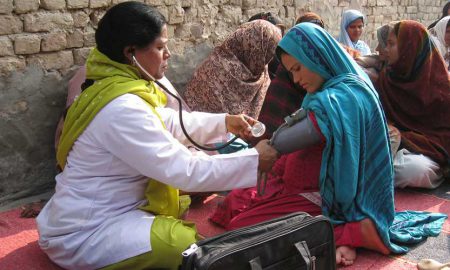
Healthcare in Pakistan is among the lowest rated in South Asia. Despite some improvements after signing the U.N.’s Millennium Development Goals (MDG) in 2000, Pakistan still has a way to go to improve its healthcare systems. Recently, Pakistan was rated 154th out of 195 countries in terms of overall healthcare system performance. Currently, only around 2% of its GDP is allocated for healthcare costs which results in it still struggling to maintain its healthcare systems. In 2017, the Prime Minister of Pakistan launched a health insurance plan to provide healthcare coverage to families earning two dollars a day or less. A family benefiting from this is entitled to an annual treatment costing $2,600. Pakistan has a mixed healthcare delivery system between public and private sectors.
The public sector health services are provided at federal, provincial and district levels. It is setup to deliver healthcare through a three-level healthcare delivery system and a range of public health interventions. Primary Healthcare is the first level. It is where patients have their first interactions with healthcare and it provides curative and preventive healthcare services. The first level includes Basic Health Units (BHUs) and Rural Health Centers (RHCs). BHUs are located at the Union Council level. It includes preventive, curative and referral services. RHCs provide promotive, preventive, curative, diagnostics and referrals along with inpatient services. They both provide support for maternal and child health services (MCH) and Lady Health Workers (LHW).

The second level is an intermediate level of healthcare which involves technical, therapeutic and diagnostic services. Specialist consultation and hospital admissions fall under this level. It is done at first and second referral facilities through Tehsil Headquarter Hospitals (THQs) and District Headquarter Hospitals (DHQs) and tertiary care including teaching hospitals. The third level is Tertiary Healthcare which is comprised of hospitals that are for more specialized inpatient care on referrals from primary or secondary health professionals.
The private sector serves around 70% of the population. Private hospitals and healthcare facilities consistently outperform their public counterparts. With the increasing population putting pressure on state health institutions, it has allowed the private sector to help with the rising demand and limited public health facilities. A number of private hospitals, clinics and diagnostic labs has increased considerably and is contributing health services in the country. The majority of private sector hospitals have sole proprietorship or a partnership model of organization. Stand-alone clinics across Pakistan are the major providers of out-patient care and the majority of these clinics falls in the sole proprietorship category. In Pakistan, around 78% of the population pay for healthcare out of its own pocket. The private sector provides three quarters of health services in the country, with the government paying the remainder.

Pakistan has made many improvements to its healthcare systems since committing to reach the MDGs. Currently, around 92% of the rural population and 100% of the urban population have access to health services. Also, after signing the MDGs the immunization rates went from about 5% to 84% with the introduction of immunization programs like Expanded Program on Immunization (EPI). Despite this though, Pakistan has one of the lowest amounts of immunized children, with overall vaccinations being about 60%. The result is a high newborn mortality rate, 69.3 deaths per 1,000 live births.
Pakistan also still has a high amount of communicable and vaccine preventable diseases like viral hepatitis, dengue, tuberculosis, malaria, typhoid, HIV and cholera. They have long been among leading causes of death. They are the result of overpopulated cities, poor sanitation, unsafe drinking water and inadequate socioeconomic conditions. While the rest of the world has nearly eradicated Polio, Pakistan had over 100 cases in 2019. There is also a stark difference between urban and rural healthcare and private and public facilities. A lot of doctors choose to practice in other countries due to the poor healthcare infrastructure so there is also a lack of qualified doctors. Pakistan is still continuing to improve their healthcare systems.
